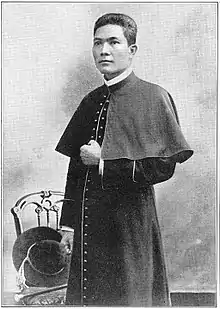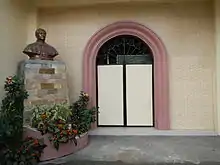Gregorio Aglipay
Gregorio Aglipay Cruz y Labayán (Latin: Gregorius Aglipay; Filipino: Gregorio Labayan Aglipay Cruz; 5 May 1860 – 1 September 1940) was a former Catholic priest who became the first head of the Iglesia Filipina Independiente, an independent Catholic Church in the form of a national church in the Philippines.
Gregorio Aglipay | |
|---|---|
| Supreme Bishop of the Philippine Independent Church | |
 | |
| Church | |
| Installed | August 3, 1903 |
| Term ended | September 1, 1940 |
| Predecessor | Position created |
| Successor | Santiago Antonio Fonacier y Suguitan |
| Orders | |
| Ordination |
|
| Rank |
|
| Personal details | |
| Birth name | Gregorio Aglipay Cruz y Labayán |
| Born | 5 May 1860 Batac, Ilocos Norte, Captaincy General of the Philippines |
| Died | 1 September 1940 (aged 80) Manila, Commonwealth of the Philippines |
| Nationality | Filipino |
| Denomination |
|
| Spouse | Pilar Jamias y Ver |
| Profession | Catholic priest, Monsignor, Bishop of Aglipayan Church, political activist, politician |
| Sainthood | |
| Feast day | 5 September |
| Venerated in | |
Known for inciting patriotic rebellion among the Filipino clergy, he was also a political activist who became acquainted with Isabelo de los Reyes, who would start an Independent Christian Filipino Church named after Aglipay in 1902.
Aglipay was previously excommunicated by Archbishop Bernardino Norzaleda y Villa of Manila in May 1899, upon the expressed permission of Pope Leo XIII. Aglipay later joined Freemasonry in May 1918. Aglipay later married Pilar Jamias y Ver from Sarrat, Ilocos Norte in 1939 and then died one year later. Followers of Aglipay through the church colloquially sometimes refer to their membership as Aglipayans.
Early life
Born in Batac, Ilocos Norte, Aglipay was an orphan who grew up in the tobacco fields in the last volatile decades of the Spanish occupation of the Philippines. He bore deep grievances against the colonial Spanish government of the islands, stemming from abuses within the agricultural system. Arrested at fourteen when a tobacco-picking worker for not meeting his tobacco quota, he later moved to the capital of Manila to study law under the private tutelage of Julian Carpio.[1]
After two years of study under Carpio, Aglipay continued his studies at the Colegio de San Juan de Letran and at the University of Santo Tomas. After obtaining his degree, he then entered the seminary in Ilocos Sur in 1883 and was ordained to the priesthood seven years later. He began a career as an assistant priest in various parishes around the main northern island of Luzon. While in Victoria, Tarlac, Aglipay gave aid to the revolutionaries and employed thirty carpenters who in reality were revolutionists in touch with the Katipunan group. Despite being a priest, Aglipay, like other revolutionaries, joined Freemasonry.[2]
Revolution
In 1898, the Katipunan was led by the Supremo, Andrés Bonifacio. Archbishop Bernardino Nozaleda asked Aglipay to confront the revolutionary leaders, offering them a level of autonomy in the future for the Philippines if they would end the rebellion. Emilio Aguinaldo, in turn, sent Colonel Luciano San Miguel to Aglipay with the intention of getting him to join the rebellion. In the course of Aglipay's journey north, the Philippine–American War started.
When Aglipay returned to Manila and discovered that the Americans had attacked, he joined the revolution. On 20 October 1898, Gen. Aguinaldo appointed Aglipay Military Vicar General of the revolutionaries. Aglipay interpreted this as making him Ecclesiastical Superior to all Filipino priests who, as such, should all be appointed Military Chaplains for the duration of the war.[3] Fighting which broke out between the U.S. and Filipino forces on February 4, 1899 prompted Aglipay to withdraw to Ilocos Norte to organize an armed resistance. On 29 April 1899, Aglipay was excommunicated for "usurpation of ecclesiastical jurisdiction.[4]
Following the end of the war in 1902, Isabelo de los Reyes was working towards the formation of a national church, that is independent of Rome. On 3 August he suggested that Aglipay be its first bishop. Aglipay, a devout Catholic at the time, was reluctant, but accepted de los Reyes' offer to establish an independent church. On 18 January 1903, Aglipay was appointed Supreme Bishop of the "Philippine Independent Church". As Supreme Bishop he allied himself with the nationalist and most radical political parties during his time like the Sakdalistas and later on even with the Socialist and Communist Parties.[4]
During the theological discussions while visiting other churches while travelling abroad, Aglipay rejected the belief in the Trinity, becoming theologically accepting of the main Unitarian belief however, his own church refused to accept his amended theology. Aglipay's unitarian and progressive theological ideas were evident in his "novena", "Pagsisiyam sa Birhen sa Balintawak", 1925[5] and its English translation, "Novenary of the Motherland", 1926.[6]

Later life
Aglipay ran for elections as President of the Commonwealth along with the Partido Komunista ng Pilipinas Norberto Nabong in a joined Republican-Communist Party ticket in 1935,[4] but lost to Manuel L. Quezon and Sergio Osmeña of the Nacionalista Party. He married D. Pilar Jamias year in 1939 since his church permits married clergy, but Aglipay died the following year on 1 September 1940.
Veneration
Aglipay is honored with a feast day on the liturgical calendar of the Episcopal Church in the United States on 5 September.
References
- University, Princeton. "The Catholic Historical Review, Volume 4". American Catholic Historical Association, 1919, p. 320.
- "Famous Filipino Mason – Bishop G. Aglipay". Most Worshipful Grand Lodge of the Philippines. Archived from the original on October 14, 2007. Retrieved 2010-01-12.
- "The First Obispo Maximo, Monsignor Gregorio L. Aglipay", Iglesia Filipina Independiente, note 16 Archived 2015-08-31 at the Wayback Machine
- Iglesia Filipina Independiente
- Aglipay, Gregorio, Pagsisiyam sa Birhen sa Balintawak Archived 2010-03-27 at the Wayback Machine, 1925
- Aglipay, Gregorio, Novenary of the Motherland Archived 2010-03-27 at the Wayback Machine, 1926
Sources
- Halili, Christine N. (2004) Philippine History, pp 192–93. ISBN 9712339343.
External links
| Wikimedia Commons has media related to Gregorio Aglipay. |
- Works by or about Gregorio Aglipay at Internet Archive
- The historical records of Archbishop Gregorio Aglipay of the Independent Church of the Philippines are in the Andover-Harvard Theological Library at Harvard Divinity School in Cambridge, Massachusetts.